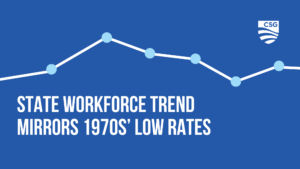By Anna Lucchese, Policy Fellow and Dalton Goble, Policy Fellow
In this rapidly changing world of workforce development, businesses are seeking to diversify their staff through a variety of ways. Hiring people with disabilities is a beneficial option for organizations to achieve this goal while addressing labor needs and obtaining competitive advantages. Studies have indicated that hiring individuals with disabilities improves profitability, productivity, customer satisfaction and inclusive work culture. To encourage these positive outcomes, state governments have worked closely to construct policies that engage the private sector and provide meaningful job opportunities for individuals with disabilities.
States have sought to accomplish this through:
Issuing tax incentives to businesses for hiring persons with disabilities and for providing employment accessibility; Providing technical assistance and engaging businesses in the policymaking process; Developing and using talent pipelines to link businesses with qualified applicants; and Including diversity and inclusion initiatives and goals in partnerships with the private sector.
This brief focuses on state examples of tax incentives, which have served as an efficient way to encourage businesses to hire people with disabilities. “Tax incentives” refers to providing tax credits to businesses that hire workers with disabilities and/or provide additional training to workers with disabilities.
Examples of State Tax Credits:
Delaware provides tax credits for businesses that hire individuals with disabilities who participate in vocational rehabilitation programs. This tax credit is accessible throughout the duration of the individual’s employment with the company. Once the employee is hired, the business is eligible to receive a tax credit equivalent to 10 percent of the employee’s wages.
Iowa provides small businesses who hire individuals with disabilities with a tax credit of 65 percent of wages for the first year of employment. To be considered a small business, there must be 20 or less full-time employees. This law defines a person with a disability as, “someone who has a physical or mental impairment which substantially limits one or more major life activities, has a history of impairment…qualifies for the targeted job tax credit as a person with a disability undergoing rehabilitation.” Within in this definition, “impairment” includes, and is not limited to, psychological conditions, anatomical loss and cosmetic disfigurement.
Some states are taking a different approach to support businesses who employ individuals with disabilities through tax credit policies aimed at the consumer. For example, the Kansas legislature passed House Bill 2044, which provides an income tax credit for taxpayers who purchase goods and services from certified vendors employing persons with disabilities. This tax credit is equal to 15 percent of the amount purchased by the qualified vendor and cannot exceed $500,000 per tax year.
Examples of Federal Tax Credits:
When constructing tax credit policies, states can draw lessons from federal tax credit programs. The Work Opportunity Tax Credit (WOTC) supports individuals who have faced barriers to employment. The WOTC provides a tax credit to businesses that hire individuals formerly involved in the justice system, vocational rehabilitation referrals and Supplemental Security Income (SSI) recipients. The Disabled Access Credit is focused on businesses that gross under $1 million and have 30 or fewer employees. This tax credit is provided to alleviate expenses that occur because of improvements in accessibility for individuals with disabilities. Examples of common accessibility expenses include access to sign language interpreters and readers, adaptive equipment and audio tapes.
Another accessibility tax credit for a business of any size is The Architectural Barrier Removal Tax Deduction and is specific to removing physical barriers in new and existing business facilities. Through this deduction, a business can receive up to $15,000 per year to pay for accessibility expenses.
In sum, tax incentive policies and programs can promote workforce growth and diversification. These measures provide support to businesses while also encouraging the employment of persons with disabilities. Such outcomes benefit the economy by addressing labor shortages within industries and reducing business tax obligations. States have achieved these goals through crafting tax incentives for businesses to hire individuals with disabilities. States also have enacted policies providing tax incentives for consumers to buy goods and services from these businesses. Employment opportunities for individuals with disabilities can be further expanded by mirroring federal programs designed to assist businesses in diversifying their workforces.





